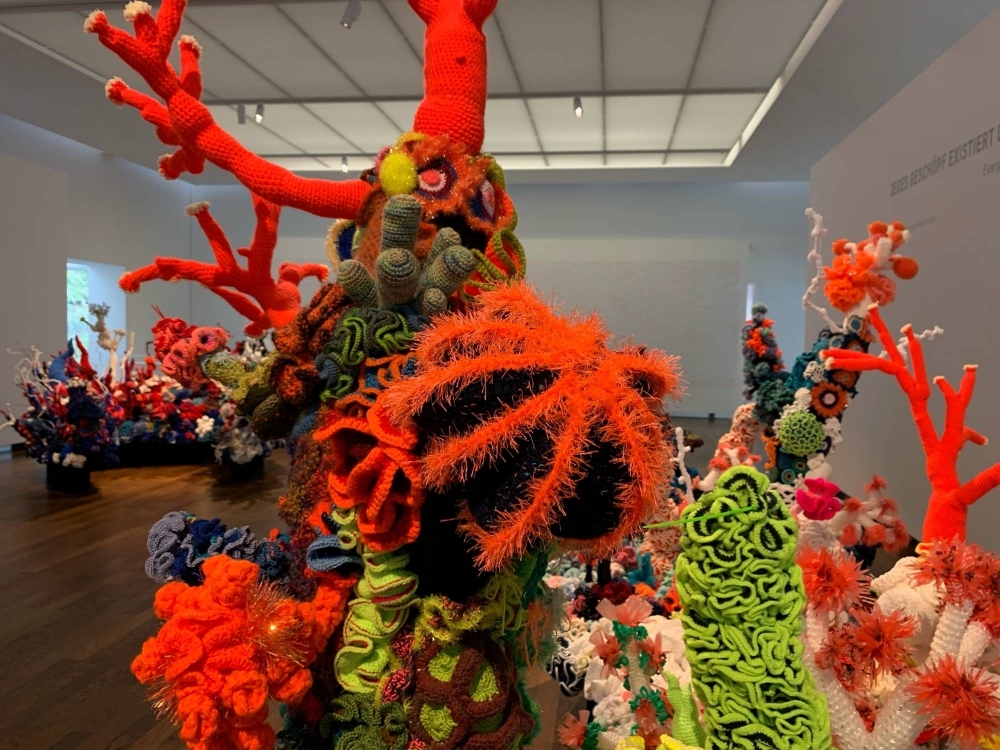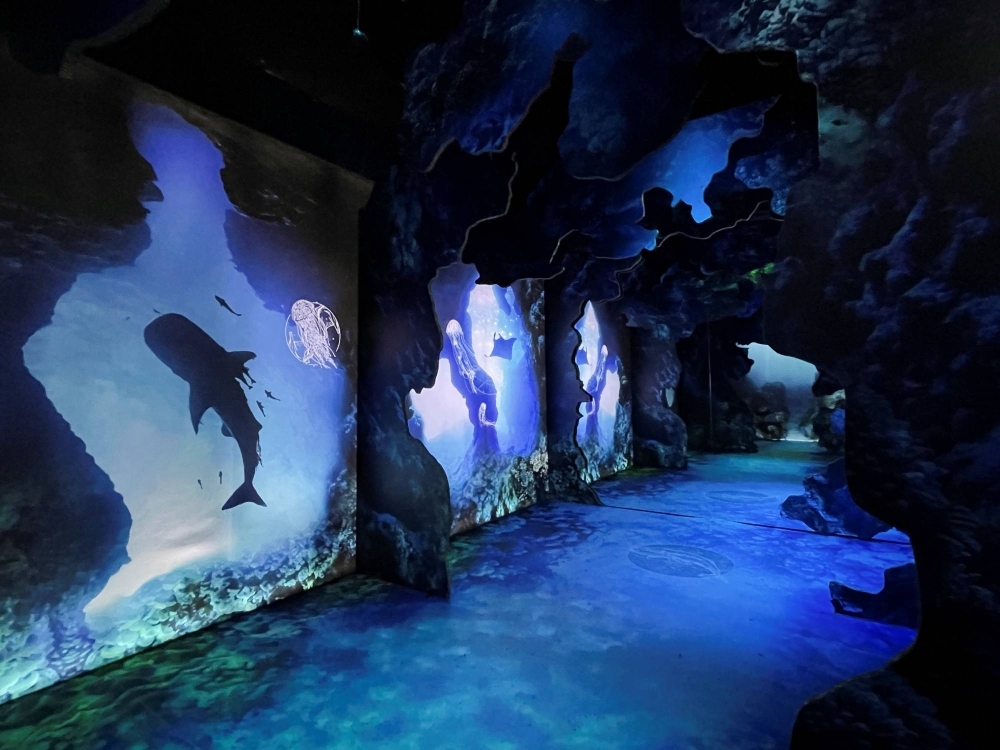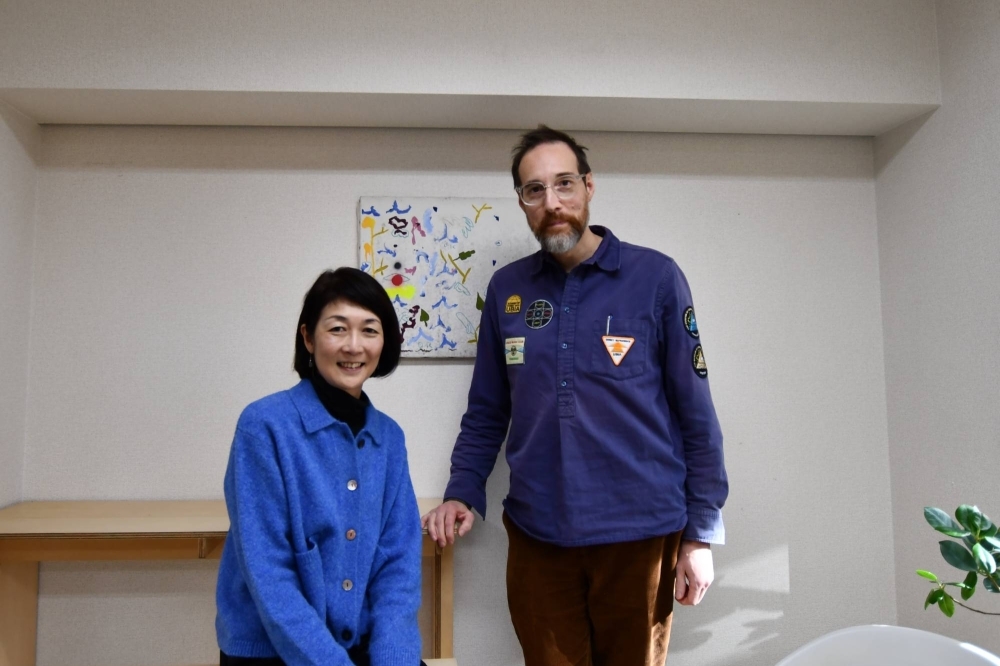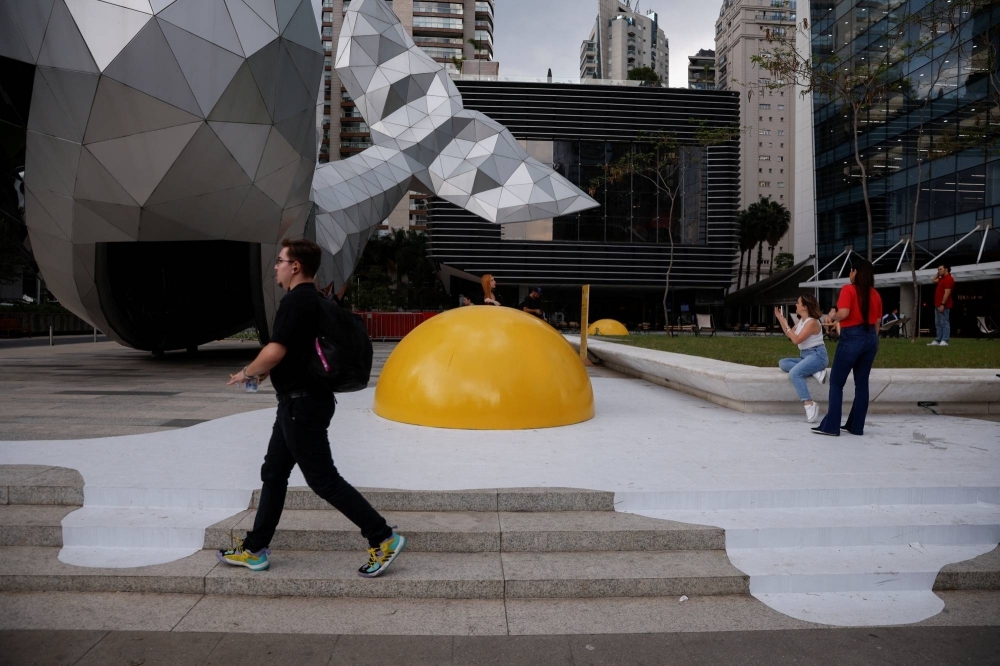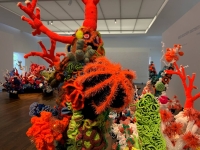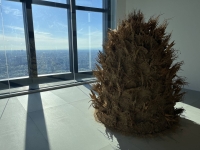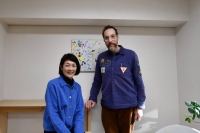In the 1970s in Tokoname, sculptor Akiko Fujita built outdoor architectural sculptures the size of buildings out of clay. Together with student volunteers in the Aichi Prefecture city known for pottery production, she proceeded to fire them in ceremonial blazes, creating whimsical structures full of curves and cubbies.
Fujita’s project was a “statement of opposition to the prevailing ethos of high economic growth,” as described in “Our Ecology: Toward a Planetary Living,” showing now at Mori Art Museum.
The exhibit itself gathers contemporary works around the theme of the environment. But in doing so it’s forced to confront a larger incongruity: For a cultural form that has historically drawn so heavily on themes of ecology and nature, art as an industry is rife with unsustainable business conventions and operates in a system of unchecked rapid expansion.
Over the last five years, it’s become increasingly clear to major art institutions that the sector has a sustainability problem. Compared with other forms of culture, like say, books, film, TV and music, art as both a pastime and an industry relies heavily on travel — often by air. Buyers fly around the world to look at works in person; artists, galleries and private collectors gather throughout the year based on a relentless calendar of fairs and events; works are zipped to global institutions under tightly controlled conditions of temperature and humidity.
And of course there are the humble viewers, for whom the chance to glimpse a masterpiece of human expression is among the reasons to get on a high-emitting long-haul flight.
All of this travel has consequences for the planet.
Toward a planetary business
On Dec. 6, Mori hosted a symposium titled “What does sustainability mean for museums?” which featured presentations by museum directors from Singapore, Australia, Hong Kong, the U.S. and the U.K.
A discomfort within the art world had been building in recent years, but it was COVID-19 that gave industry leaders a chance to reflect inwardly on how much they were contributing to climate change. Among the most visible pioneers has been British institution Tate, which declared a “climate emergency” in 2019 and conducted a carbon audit in hopes of cutting its footprint across its galleries by at least 10% by 2023. It ultimately exceeded the goal, reaching a 60% reduction, due in part to the pandemic, said Frances Morris, director emeritus of Tate, during her talk.
Museums and commercial galleries have focused on more sustainable energy-use, such as by employing more efficient heating, ventilation and air conditioning, installing solar panels, switching to LED bulbs and using ground source heat pumps.
The climate crisis has also necessitated a shift in mentality: As Museum of Modern Art (MoMA) director Glenn Lowry said at the symposium, “10 years ago when energy wasn’t a primary concern, I loved walking by the museum at night when it was lit up; it felt exciting. Today we understand that’s a use of materials and energy that is simply unacceptable.”
Although the art sector isn’t even close to some of the highest emitting industries — total emissions are an estimated 70 million metric tons of carbon dioxide equivalent per year, compared with 1.2 billion from fashion or the roughly 900 million produced from commercial aviation — it’s relatively carbon intensive considering its economic size.
And more importantly, as Roger McDonald of Arts Initiative Tokyo points out, it has an excise role in the popular imagination. McDonald and Yuko Shiomi were part of a group that founded the nonprofit in 2001, and in the last three years they have taken on sustainability in the local art scene as one of their causes.
“Art and culture generally have a disproportionate amount of social messaging responsibility, because nature is something which really enriches people's lives through visual language, music and other forms,” he says.
Archipelago problems
An archipelago off the edge of East Asia whose closest neighbor is at least an hour flight away, Japan’s relative isolation and popularity as a tourist destination means its fine art sector is a carbon emissions wellspring.
Japan’s arts industry has a unique challenge very simply because you cannot drive or catch a train to it.
That’s true both for visitors to Japan’s arts institutions and those working within it. “For the art scene, every gallery or museum must involve a plane,” says McDonald. “If you’re going to an art fair, if you're going to sell a painting, invariably you’ve got to get on a plane.”
Art is a commodity, and as such its buyers and handlers are accustomed to speed and pristine presentation, but this is beginning to shift as galleries and museums realize the environmental benefits of sea freight and alternate packaging. But unfortunately, in Japan shipping options and recyclable crate systems remain limited, says McDonald.
Japan also favors blockbuster exhibits — huge shows of mainstream crowd-pleasing works that bank on scale and scope — which eat up a lot of funding and resources and require a great deal of materials and energy.
Just as a handful of Japanese galleries and museums are starting a conversation about sustainability, elsewhere the industry wants desperately to expand. This year, a new large-scale art fair called Tokyo Gendai opened to take advantage of new tax revisions that relaxed the cost of bringing in art from overseas. It was billed as the “first international art fair to be held in Tokyo Bay in over 30 years” and boasted that it brought in 73 international galleries.
“(Museums) have a stark choice here,” Tate’s Morris said at the Mori symposium. “Should we... not also be questioning the last decades of unbridled growth?” The irony was hard to ignore: She pointed to the massive expansion in museum construction across Asia — to a room full of people sitting in Roppongi Hills, a megacomplex built just 20 years ago by the billionaire construction tycoon Minoru Mori.
Early days
The biggest challenge facing Shiomi and McDonald is a lack of awareness in Japan, among viewers, buyers, curators, directors, even artists. That’s a refrain you might have heard in the U.S. or U.K. a decade ago. Japanese artists on the whole aren’t active protesters, and don’t necessarily see themselves as agents of change as Western artists often do.
“There are so many artists who are dealing with nature as a subject matter, but there aren’t many who are trying to tackle this structure,” says Shiomi.
But there are ways artists could use sustainability challenges to their creative advantage.
Aron Landahl is an artist and picture book illustrator from Sweden who’s made a conscious decision to eschew plane travel. So in 2019, having been accepted as a resident at Arts Initiative Tokyo, he began the long journey from Sweden to Japan, by way of ferry (Stockholm to St. Petersburg, Russia), Trans-Siberian Railway (St. Petersburg to Irkutsk, Russia), Trans Mongolian Railway (Irkutsk to Ulaan Bataar, Mongolia, to Beijing), express train (Beijing to Shanghai), ferry (Shanghai to Kobe) and finally train (Kobe to Tokyo).
The journey took 20 days instead of 16 hours. Even so, Landahl had his qualms.
“As ferries can have quite high emission rates, that part of the route was the worst in this sense,” he writes by email. “But it is difficult to reach Japan without those ferries.” Despite the obvious inefficiency and extra burden, the artist was able to use his experiences, photographing iterations of Hokusai's “The Great Wave” throughout the different countries he visited, for his residency.
Perhaps the most visible artist globally who’s taken up the sustainability mantle is Icelandic Danish multimedia artist Olafur Eliasson. Starting in 2014, as a statement on climate change, he and geologist Minik Rosing transported free-floating icebergs from Greenland to public city spaces for “Ice Watch.” Eliasson is the head of a studio employing around 100 people who create large-scale works and projects that move around the world, so it stands to reason that he bears greater responsibility for his footprint than the average potter using local clay and selling wares to domestic buyers.
He in turn makes that responsibility public. Eliasson worked with U.K. nonprofit Julie's Bicycle to track and publish emissions from his own works: “Ice Watch London 2018” amounted to 55 metric tons of CO2 equivalent, or roughly the emissions of “about 52 people flying return from London to witness the icebergs melting,” the report notes.
Unfortunately, say Shiomi and McDonald, Japan doesn’t have a celebrity artist who is taking up the sustainability cause with the vigor of Eliasson.
Shiomi also sits on the committee for the Tokyo Metropolitan Government’s cultural policy plan. The report published last year looks at art in the metropolis for the next decade. It includes the bullet point: “Leading museums and galleries abroad are already active in approaches to the environmental crisis facing the planet, including climate change. Tokyo needs to also take the lead in action toward these social issues.” “I mean, they haven't done nothing yet,” Shiomi says wryly. “But as you know: You have to put a line in the plan.”
Tourism woes
But perhaps the biggest challenge for the industry to reckon with is an existential one.
According to a Julie's Bicycle report released in 2021, less than a quarter of the sector’s total carbon footprint comes from people who create, buy and display art, like public art institutions and artists — the vast majority comes from the people who see it. The report estimated that visitor travel adds 52 million metric tons of carbon dioxide equivalent, making up 74% of the sector’s total emissions.
At the Mori symposium, participants hammered home the fact that the overwhelming majority of emissions — 92% in the case of Tate — come from visitor travel. The contradiction lies heavy: The more popular a show, the worse it is for the planet.
“It’s a complete paradox,” MoMA’s Lowry tells The Japan Times. “We’ve come to realize that there is an inherent tension between the publics we serve and the impact they have on the environment and the work we do.”
“They are our audience, they are our lifeblood,” Morris said during her talk at the symposium. “Young people come from all over the world to visit our museum — but this is really, in the longer term, where we have to act.”
So does it mean the museums should close, or the public should stop going to see art? To both questions, Heath Lowndes, managing director of the U.K.’s Gallery Climate Coalition, one of the organizations spearheading sustainability in art globally, says no.
“Everyone needs to make changes in the areas that they have influence,” he says, “What we need to do is measure and reduce, and we need to be mindful.”
For tourists and art lovers, that could mean taking fewer and longer transatlantic or transpacific trips per year, and flying economy instead of first class.
Meanwhile, Art Initiative Tokyo’s McDonald says he believes we put too strong an emphasis on going to see originals, whereas exhibitions of reproductions were once commonplace.
“You don’t have to go to Madrid to see (Picasso’s) ‘Guernica’ a dozen times in your life. It’s almost more like a pilgrimage: Maybe you go once.”



